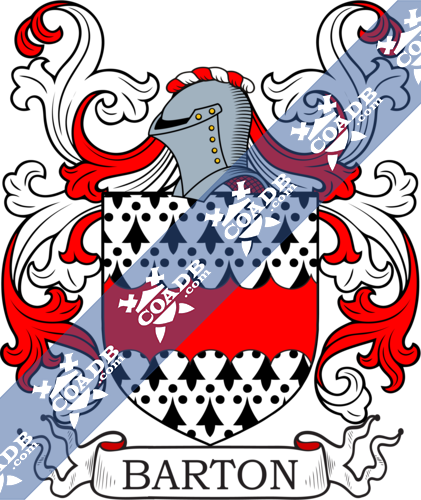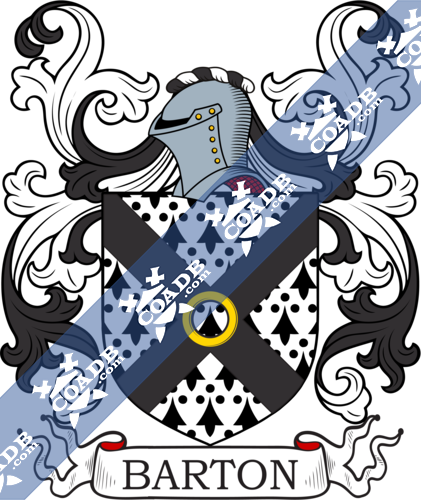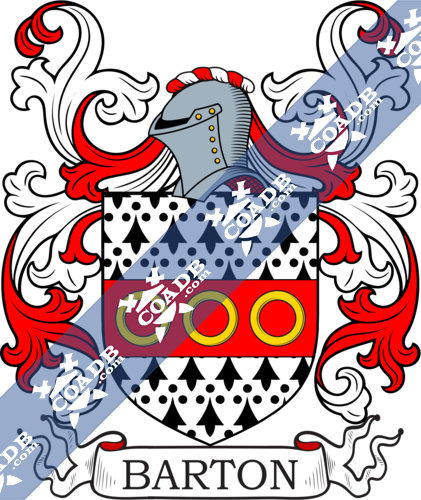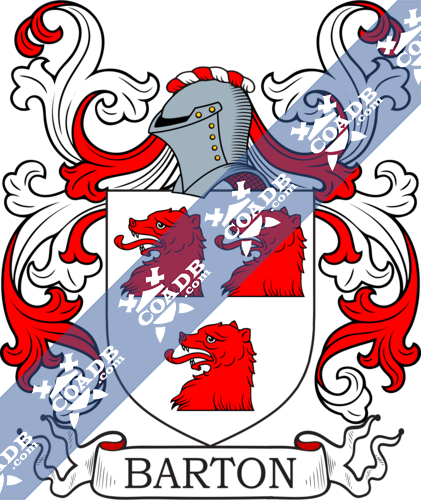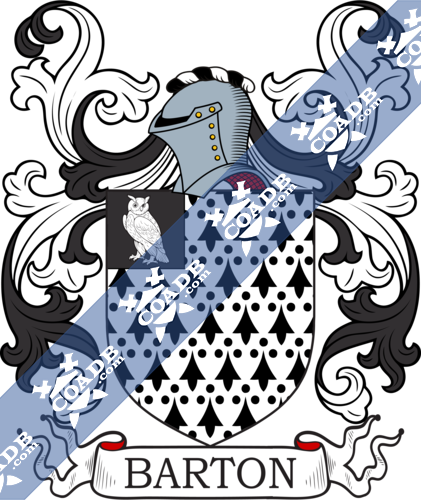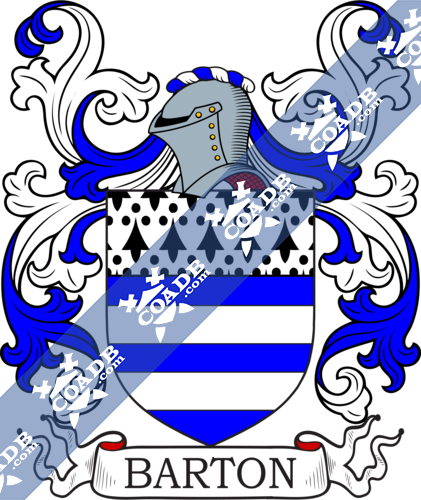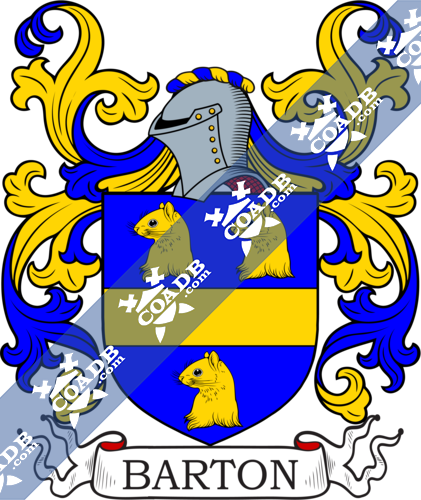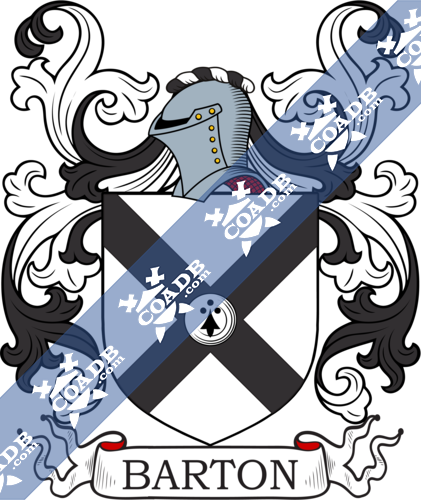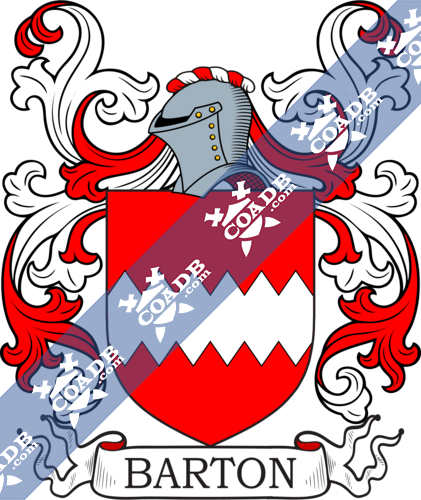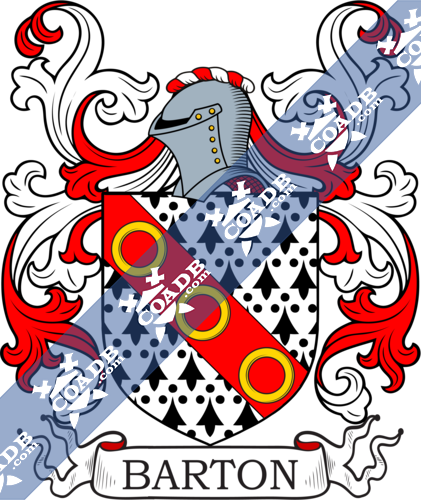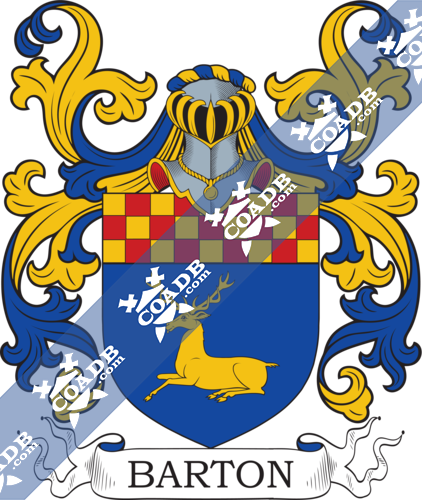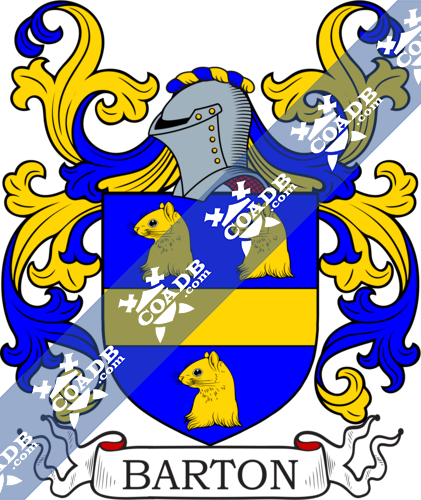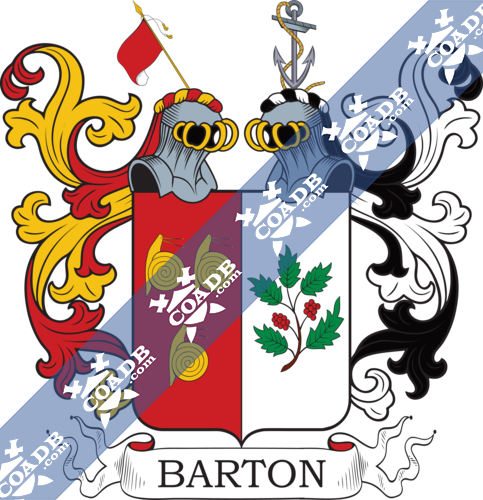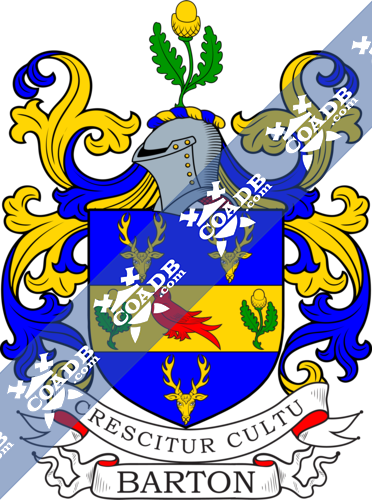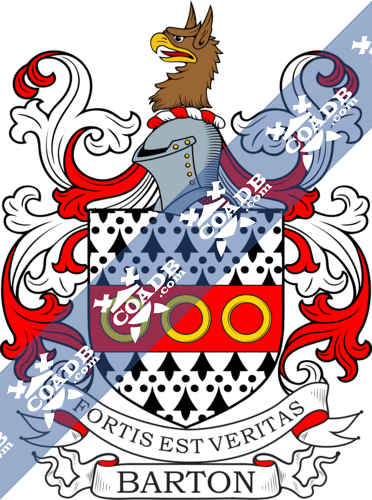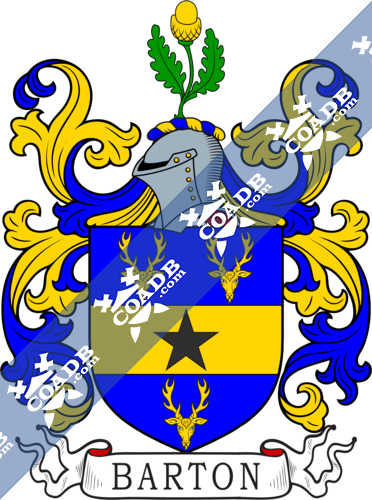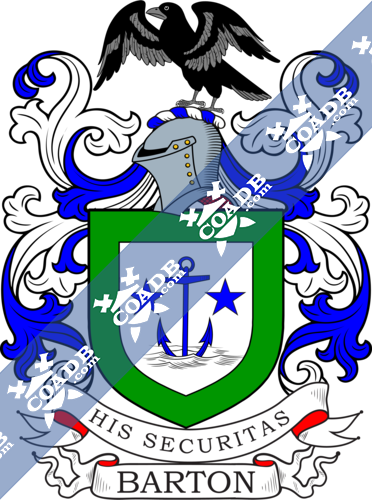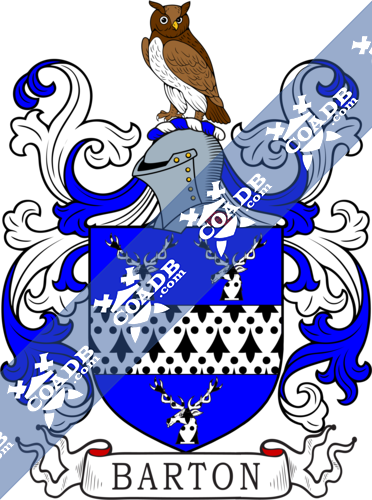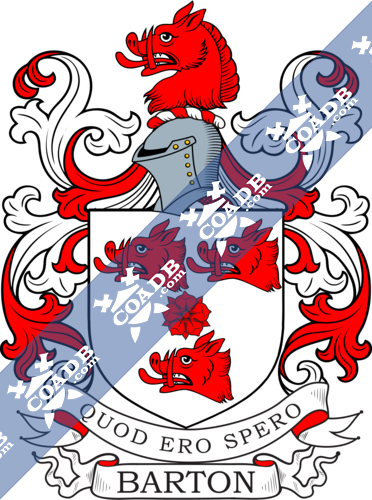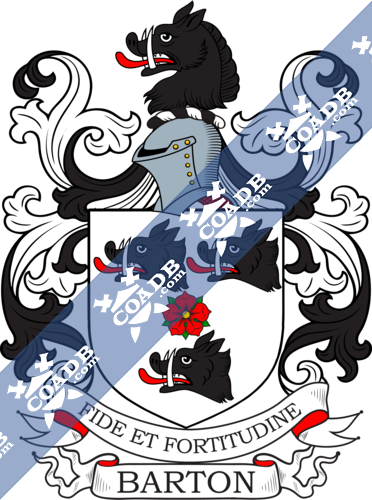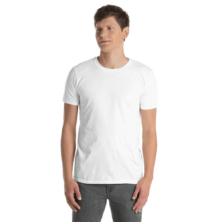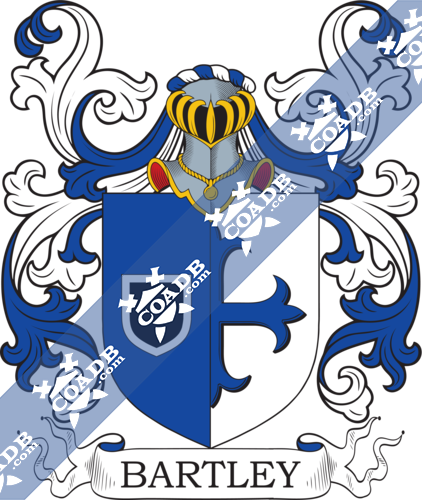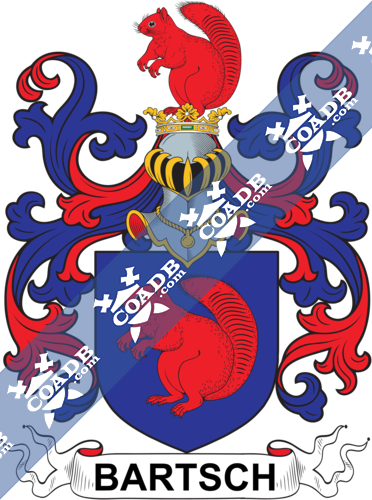Barton Family Crest, Coat of Arms and Name History
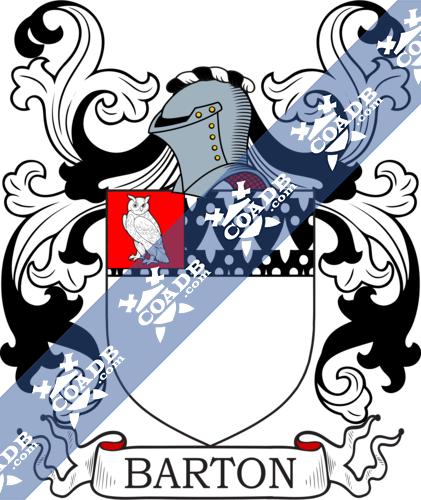
Barton Coat of Arms Gallery
Don’t know which Coat of Arms is yours?
We can do a genealogical research. Find out the exact history of your family!
Learn MoreBarton Surname Meaning, Origin, History, and Etymology
This is an English (and Scottish) habitational name which denoted a person who lived in or was from any of the various towns/villages named Barton, from the Old English or Anglo-Saxon words bere or bær, meaning barley, and the word tun, meaning settlement or enclosure, referring to an outlying grange. In other words, the towns were named after the barley croft. Such places include Barton in Staffordshire, recorded in the Anglo-Saxon Chronicle of 942 AD, and as Bertone in the Domesday Book of 1086 AD, as well as Barton in Gloucestershire, Lincolnshire, Warwickshire, and Herefordshire, all recorded as Bertone in the Domesday Book, and lastly Barton in Kent, Suffolk and Barton in North Riding of Yorkshire. In his book Patronymica Britannica, Mark Anthony Lower states “The Gazetteer gives thirty-seven parishes, towns, and places so called in various counties of England”. A similar theory is offered by Bernard Homer Dixon in his 1857 book Surnames: “Barred or Fenced town, Manor; also Corn-farm or village”.
There is a second origin theory for Barton. Some believe the place name that generated the surname was Dunbarton, in Scotland, the capital of the ancient Kingdom of Strathclyde, an early medieval kindom of Britons that existed from the 400s AD to 1093 AD. In Gaelic, Dunbarton means “fort of the Britons”
In Germany and some parts of central/eastern Europe (ex. Czech Republic, Poland, and Slovakia), the name may have developed as a pet form (nickname) from the personal (first) name Bartolomaeus, from Bartholomew. Bartholomew was one of the twelve apostles of Jesus Christ, born in Cana, Judea, Roman Empire in the 1st century AD. Wikipedia recounts a well-known miracle he was purported to have performed: “The people of Lipari celebrated his feast day annually. The tradition of the people was to take the solid silver and gold statue from inside the Cathedral of St Bartholomew and carry it through the town. On one occasion, when taking the statue down the hill towards the town, it suddenly became very heavy and had to be set down. When the men carrying the statue regained their strength, they lifted it a second time. After another few seconds, it got even heavier. They set it down and attempted once more to pick it up. They managed to lift it but had to put it down one last time. Within seconds, walls further downhill collapsed. If the statue had been able to be lifted, all the townspeople would have been killed”.
Spelling variations or names with similar etymologies include Berton, Bartons, Bartone, Barten, and Bearton. One source asserts the name first established itself in Cheshire, England. In his 1848 book titled A Topographic Dictionary of England, Samuel Lewis states “The manor [of Barton] was anciently held under the barony of Malpas by the family of Barton, some monuments of whom, with their effigies, were formerly to be seen in Farndon church”. A prominent branch of the family was established in Lancashire, of which Lewis writes “Barton Old Hall, a brick edifice, now a farmhouse, was the seat successively of the Barton, Booth, and Leigh families”.
Early Bearers of the Barton Last Name
One of the earliest known ancestors of this family was Leysing Barton who was born in Barton, Preston, Lancashire, England c. 1120 AD. He had a son named Matthew. Matthew de Barton was born in the same town c. 1150 AD. He had a daughter named Edith who was born in the same town c. 1162. She had a daughter named Cecily de Barton who was born in Lancashire, England c. 1180 AD. She married William de Notton and had two issue with her: Gilbert and Avina. The son, Sir Gilbert de Barton, was born c. 1202 AD in Barton, Lancashire, England. He had issue as follows: Roger, Agnes, Amery, and Gilbert. The following is an excerpt from Rootsweb of a book a titled A History of the County of Lancaster: “Gilbert, the eldest son of William and Cecily, was a minor in 1220 at the death of his grandmother Edith, but had livery of his lands two years later; he adopted Barton as a surname, and was made a knight. He fell into the hands of Aaron, the Jew of York, and parted with large portions of his lands, and finally sold his great lordship to Robert Grelley his feudal superior. This sale was confirmed by his son John. Gilbert retained or regained the manor of Barton, but this was given to his daughter Agnes, perhaps in view of her marriage with a Grelley, and her daughter and heir Loretta by marriage with John del Booth, about 1292, carried it into a family which, as Booth of Barton, retained it for 300 years. John de Barton, the son of Gilbert, retained lands in the township which his descendants enjoyed for some generations; occasionally they laid a claim to the manor”.
Paganus de Barton was documented in Yorkshire, England in 1163 AD. The Hundred Rolls of 1273 AD, a census of Wales and England, known in Latin as Rotuli Hundredorum lists two bearers of this surname: William de le Berton (Wiltshire), John de la Berton (Kent), and Reginald de la Berton (Gloucesershire). Thomas de Bartone of Ayrshire was recorded in 1296 AD in Scotland. Adam de Bartone of Berwickshire was recorded in Scotland in 1296 AD as well. John de Bertoun was documented in Lanark, Scotland in 1432 AD.
Barton Family Genealogy and Family Trees
There are many landed, noble, or aristocratic branches of the Barton family tree. Several are discussed below.
Barton of Stapleton Park
The lineage of this branch of the Barton family tree traces back to William Andrew Barton Esq., stated to have been a scion of the Smithills line, who procured the estate of Deanwater, Chester, England, along with other lands. One of his descendants was George Barton Esq., who in 1720, married Lucy, daughter of J. Segar, Esquire of Catley, county York, and had four sons with her as follows: Richard, John (married Sarah, daughter of J. Bradshaw of Darcy Lever, Lancaster), George (married Mary Rainos) and Henry. His son Henry was an Esquire who purchased considerable land as a merchant in Manchester, including the estates of Swinton and Ward Hall, co. Lancaster. In 1768, he married Mary, daughter of Joseph Bushnell of Neston, and had the following children with her: 1) John (his heir), 2) Henry (married Elizabeth, daughter of John Watson of Preston), 3) Richard Watson (of Springwood, married Mary, another daughter of John Watson, and had a son named Richard Barton who was an Esquire of Caldly Manor, and a Justice of the Peace and Deputy Lieutenant), 4) Mary (married John Baldwin of Ingthorp Grange), and 5) Sarah (married R.-W. Robinson of Preston). His son, John Barton, Esquire if Swinton and Saxley, was born in 1770. He was a Deputy Lieutenant and was a prominent merchant. In 1796, he married Margaret, daughter of John Warson of Preseton, and had three children with her: John Watson (heir), Mary Elizabeth (married Thomas Hepwood of Hope End), and Sophia (married Jeremiah Taylor of Prestbury Lodge, Lieutenant General and Colonel of the 59th foot). He was succeeded by his eldest surviving son, John Watson Barton, who was born in 1798. John was an Esquire, Justice of the Peace, and Deputy Lieutenant who purchased Stapleton Park in county York, England in 1833. In 1830, he married Juliana, daughter of James Hope of Moray Place, Edinburgh, Scotland, and had the following issue with her: 1) John Hope, 2) Mary Jane, 3) Julia Sophia (married Reverend Charles August Hope, son of Sir John Hope of Craig Hall), 4) Margaret (married Charles Warren Markham, son of Lieutenant-Colonel Markham of the 60th Rifles), 5) Louisa, 6) Caroline (married William Clayton Browne, son of Robert of Browne’s Hill), and 7) Frances. He died in 1840 and was succeeded by his son. This son, John Hope Barton, Esquire of Stapleton Park, Justice of the Peace, and High Sheriff of county York, was born in 1833. In 1872, he married Florence Mary Annabella, daughter of Henry James Ramsden and Frederica Selina Law, and had one son with her: Henry. This son, Henry John Hope Barton, Esquire of Stapleton Park, county York, and Saxby Hall, county Lincoln, England, was born in 1873. He succeeded his father in 1876. The Barton family crest for this branch of the family tree is blazoned in the medieval European art of heraldry as follows: Azure, on a fess, between three buck’s heads, cabossed, or, a martlet gules, within two acorns, leaved, proper. Crest: An acorn or, leaved vert. Motto: Crescitur cultu. This branch of the family was seated at Stapleton Park and Saxby Hall.
Barton of Grove
The genealogy of this family is traced back to the ancient Lancashire house of Barton of Barton Hall, which was established in Ireland by Thomas Bartyon, who accompanied the 2nd Earl of Essex, Robert Devereux, into said kingdom, and in the process, obtained grants of land in Drumminshin and Necairn, county Fermanagh. He married Margaret Loyd, and had a son with her named Anthony. Anthony in turn had a son named William. This William Barton was born around 1630 and he married Jane Hannah Foster, and had two sons with her as follows: 1) Edward (had sons named William and Edward, from whom Baptist Johnston Barton descended) and 2) William. The son William had two issue: Elizabeth (married Edward Barton her cousin) and Thomas. Thomas Barton was an Esquire of Curragmore who was born in 1694. He was a merchant and lived in Bordeaux in 1725. In 1722, he married Margaret, daughter of Robert Delap of Bailyshannon, and had a son with her named William. This William Barton was an Esquire of Grove, county Tipperary, Ireland, who in 1754, married Grace, daughter of Reverend Charles Massey of Doonas, and had the following issue with her: 1) Thomas (his heir discussed more below), 2) William (of Clonelly, married Anne Isabella Warren, had sons with her named Folliott Warren and Edward George), 3) Charles (see Barton of Waterfoot), 4) Hugh (of Staffan), 5) Sir Robert (Lieutenant-General in the Army, had children named Hugh, France, Maria, and Alexandrine), 6) Dunbar (of Rochestown, High Sheriff, married Elizabeth Riall, had issue named Samuel William, Dunbar Thomas, Augustine Hugh, and Thomas Henry), 7) Grace (married John Palliser of Derryluskan), 8) Elizabeth (married Lieutenant General Sir Augustus Fitzgerald, Baronet), and 9) Margaret (married Lord Massy). The eldest son, Thomas, was an Esquire of Grove, and a Member of Parliament. He married Mary, daughter of General Ponsonby, and had the following children with her: 1) William (see below), 2) Chambre Brabason (Lieutenant Colonel of the 2nd Life Guards), 3) Charles Robert (field officer), 4) Mary (married George, son of Lord Robert Fitzgerald), 5) Grace (married Lieutenant Colonel Pennefather of Newpark and later Major Michael-Angelo Galliazii of the Austrian Service), and 6) Catherine (married Edmund Staples of Dunmore). His oldest son, William Barton, was an Esquire of Grove born in 1790. He was a Justice of the Peace, Deputy Lieutenant, and High Sheriff. In 1815, he married Catherine, daughter of Samuel Perry of Woodroffe, and had the following issue with her: 1) Thomas Barker, 2) Samuel Harry, 3) William Hugh (married Mary Blakeney, had five sons and four daughters), 4) Deborah (married John Wade of Meath), 5) Mary Frances (married Charles Shaw, son of Sir Robert Shaw, Baronet), 6) Catherine Grace, 7) Anne Margaret (married George Gough of Rathronan), and 8) Emily Martha. He died in 1857 and was succeeded by his son Thomas, and then by his son Samuel. Samuel Harry Barton was an Esquire of Grove, county Tipperary, Ireland who was born in 1817. He was a Justice of the Peace and Deputy Lieutenant. In 1862, he married Mary Elizabeth, daughter of Major Frobisher of the Bengal army, of Cheltenham, and had five children with her as follows: William Henry Hugh (1871), Charles Robert (1877), Rose, Catherine, and Florence. The Barton coat of arms is blazoned as follows: Argent, a rose between three boars’ heads, erased, gules. Crest: A boar’s head gules. Motto: Quod ero spero. Ancient Motto: Vis fortibus arma.
Barton of Waterfoot
The ancestry of this branch of the family tree begins with William Barton, Esquire of Grove, and his wife Grace, daughter of Reverend Charles Massey, who had a son named Charles. This son, Charles Barton, was an Esquire and Lieutenant General, who in 1800, married Susannah, daughter of Nathaniel Johnson of Bordeaux, and had the following issue with her: 1) Hugh William (his heir), 2) Nathaniel Dunbar (Lieutenant Colonel of the Bengal Cavalry, married Honoria Lawrence), 3) Thomas Charles (of Bonn), 4) Robert (of Syndey, Australia, Justice of the Peace, married Emily Darval), 5) Albert Evelyn, 6) Susannah (married Reverend John Stirling), and 7) Anna Eleanor (married Reverend F.-D. Maurice). He died in 1821 and was succeeded by his eldest son Hugh. Hugh William Barton was an Esquire of The Waterfoot, Deputy Lieutenant, Justice of the Peace, and Lieutenant Colonel of the 2nd Life Guards, born in 1800. In 1832, he married Mary Caroline, daughter of Robert Johnston of Kinlough House, and had the following children with her: 1) Charles Robert (heir), 2) James (Lieutenant of the Royal Army, married Mary Barbara Barclay), 3) Folliott (married Florence Maude, daughter of Hugh Montgomery of Belhavel), 4) Hugh St. George (of the late 60th Rifles), 5) Robert (Royal Navy), 6) Thomas Lloyd, 7) Nathaniel Albert Delap (1857), 8) Florence Anna, and 9) Mary Everina (married James M. Sinclair of Holly Hill). Charles Robert Barton, Esquire of Waterfoot, was a Justice of the Peace for county Fermanagh, High Sheriff, and Captain of the Fermanagh Militia who was born in 1832. In 1872, he married Henrietta Mervyn, daughter of Henry Mervyn Richardson of Rossfad, and had one son with her: William Hugh, born 1874. This branch of the Barton family tree bears the same crest, arms, and motto as the Barton’s of Grove.
Barton of Strafan House
This branch is related to the Grove branch and was established by Hugh Barton, son of William Barton and Grace Massey, who through his own industry, acquired the estate of Bordeaux, Chateau Langoa, and vineyards in the parish of St. Juliens-Medoc. The author Burke writes of him as follows: “Mr. Hugh Barton was universally respected and beloved, and gained great esteem on account of the judicious employment of the wealth he had acquired, and the vast amount of good he did to all who came within its influence”. He was also the High Sheriff of Kildare, Ireland in 1840. In 1791, he married Anne, daughter of Nathaniel Johnston of Bordeaux, and had the following children with her: 1) Nathaniel (of Straffan), 2) Thomas Johnston (of Glendalough), 3) Daniel (Captain of the 7th Fusiliers, married Ms. Sampson), 4) Hugh, 5) Isabella, and 6) Susan Elizabeth (married the 3rd Lord Clarina in 1828). He died in 1854 and was succeeded by his eldest son Nathaniel. This son, Nathaniel, was an Esquire of Straffan House, Justice of the Peace, Deputy Lieutenant, and High Sheriff who was born in 1799. In 1823, he married Mary Susanne, daughter of Harry Scott and Anne Ogle, and had the following issue with her: Hugh Lynedoch, Harry Fitzgerald, Bertram Francis, Charles Thomas Hugh, Francis Savile, Mary Esther Isabella, Anna Susanne Fredericka, Isabella Charlotte, and Alice Catherine Harryette. He died in 1867 and was succeeded by his son Hugh. Hugh Lynedoch Barton was an Esquire of Straffan House, county Kildare, was born in 1824. In 1855, he married Anne Emily Massey, daughter of Eyre, 3rd Lord Clarina. This family bore the same coat of arms as Barton of Grove. The family motto is Fide et fortitudine.
Barton of Glendalough House
Thomas Johnston Barton was an Esquire of Glendalough, county Wicklow, Ireland, was born in 1802. He was a Justice of the Peace and Deputy Lieutenant. In 1830, he married Frances, daughter of Edward Morris, and had the following children with her: 1) Thomas Erskine (his heir), 2) Hugh Massey (served in the 7th Foot), 3) Charles William (see below), 4) Robert Johnston (Captain of the Coldstream Guards), 5) Frances Isabella (married James C. Hart of Drumcrosshall, Captain of the 16th Lancers), 6) Georgiana Susanna Arabel (married George Booth), 7) Anna Mary Henrietta (married R.C. Childers, son of Reverend Charles Childers, Chaplain at Nice), and 8) Beatrice Louisa (married Hugh F. Massy, Captain of the 19th Regiment). He died in 1864. He was succeeded by his eldest son Thomas, and then Charles. Charles William Barton was an Esquire of Glendalough House, county Wicklow, and a Justice of the Peace, born in 1846. In 1876, he married Agnes, daughter of Reverend Charles Childers. They bore the same “family crest” as Barton of Grove.
Barton of Greenfort
Gustavus Barton, Esquire, was the son of William and grandson of Edward Barton, who around 1772, married Harriett, sister and co-heiress of Baptist Johnston of Monaghan, through whom he received the estate of Drumsallogh, and had two issue with her as follows: Baptist-Johnston and Edward (Archdeacon of Ferns). The elder son, Major Baptist-Johnston Barton, of Drumsallogh, county Monaghan, Ireland was born in 1774. In 1815, he married Catherine Babington, heiress of Greenfort, sister of Ralph Edward Babington, and had two daughters and one son with her. The son, Baptist, was an Esquire of Greenfort, who married, in 1842, Maria, daughter of William McLaughlin, Esquire of Ramelton, and had three children with her: 1) Baptist Johnston, 2) Ellen, and 3) Kate. His only son, Baptist Johnston Barton, Esquire of Greenfort, county Donegal, Ireland was born in 1848. He was a High Sheriff in 1877. In 1875, he married Isabel, daughter of Robert McClintock of Dunmore, and had issue with her as follows: Baptist Johnston (born 1876).
Barton of Threxton House
The progenitor of this line was Thomas Barton of Halow who lived in the middle of the seventeenth century in England. His descendant, Thomas Barton, Esquire, brother of John, was the grandfather of Walter Barton May, was born in 1726. He married Susannah Ellis and had one daughter and son with her. The daughter married John Burcham of Holt. The son, Walter Barton, Esquire, married Ann Hannah Pigge, and had three sons and six daughters with her. One of his sons, Thomas Barton, was an Esquire of Threxton House, who in 1810, married Hannah Clarke and had three children with her: Thomas Edward, Sarah Anne Hannah, and Elizabeth. Thomas Edward Walter Barton, Esquire of Threxton House, county Norfolk, England (modern day United Kingdom) was a Justice of the Peace born in 1811. In 1844, he married Eliza, daughter of John Allday of Griston, and had four issue with her as follows: 1) Thomas Allday (1845), 2) Walter May (1846), 3) Gertrude Eliza (1848), and 4) Alfred John (1850). He succeeded his father in 1837.
Barton of Clonelly
William Barton, Esquire, was born 1758, son of William of Grove. He succeeded to the estate of Clonelly, county Fermanagh, Ireland. In 1796, he married Anne Isabella, daughter of Folliott Warren of Lodge, and had two children with her: Folliott Warren and Edward George (barrister-at-law). He died in 1835. This family bore the same arms as Barton of Grove.
Barton of Rochestertown
Dunbar Barton was an Esquire and High Sheriff of Tipperary, son of William Barton and Grace Massey, acquired the lands of Rochestown in 1809, upon the death of Lawford Miles, his wife’s maternal uncle. In 1798, he married Elizabeth, daughter of Reverend Sameul Riall, and had children with her as follows: Samuel William (of Rochestertown), Dunbar Thomas (Lieutenant 1st Royal Dragoons), Augustine Hugh (married Emily, daughter of James Martin of Ross), and Thomas Henry (married Charlotte, daughter of John Plunkett). Samuel William Barton was an Esquire of Rochestown, county Tipperary, Ireland who was born in 1803. In 1831, he married Emma Maria, daughter of Christopher Hely Hutchinson, Member of Parliament for Cork, and had the following children with her: Christopher (1835), Dunbar Henry (1841), Crosbie (1845), William Archer (1849), Elizabeth, Anna Grace, Mary, and Evelyn Isabella. They bore the same arms, crest, and motto as Barton of Grove.
Barton of Australia
This branch of the Barton family tree descends from John Barton of Holme, county Nottingham, England, a merchant of Staple, who died around 1490. His son, Ralph Barton, married Joan, daughter of heiress of Sir Ralph Radcliffe of Smithills, was the progenitor of the Bartons of Smithills. John Everard Barton was born in 1794. In 1819, he married Elizabeth Mee, daughter of Robert Jacques of Montreal, and had issue with her. Their son, John Everard Barton of Astley Hall, Stourport, county Worcester, was born in 1825. In 1848, he married Sarah Merritt, and had issue with her as follows: 1) Everard William (Justice of the Peace), 2) Frederick George, 3) Charles Tom (had two sons and two daughters), 4) Harry Alexander (Deputy Attorney General in British Columbia), 5) Katherine Mary, 6) Helen Elizabeth, and 7) Lillian Sarah (married Thomas Needham Wilson, and had one daughter). George Frederick Barton of Kajuligah, Ivanhoe, Moulbong, Booligal, New South Wales, was a Justice of the Peace born in Australia in 1851. In 1882, he married Annie Rachel Warner Sleigh, grand daughter of Serjeant Sleigh, and had issue with her as follows: 1) Everhard Arthur Hale (1894), 2) Evelyn Mary (1883), 3) Winniefred Millie (1884), 4) Constance Everard Campbell (1886), and 5) Mabel Lilian (1892). The Barton coat of arms is blazoned in heraldry as follows: Per fess argent and azure four stags’ heads caboshed, two and two, within a bordure thereon eight crescents, all counterchanged. Crest: On a mount between two accords stalked and leaved an owl, all proper. Motto: I byde my time. Estates: Kajuligah, Ivanhoe, Moulbong, Booligal, New South Wales. Residence: Astley Hall, Stourport, Worcestershire, England.
Barton of New Zealand
This branch of the Barton family tree descends from Richard Barton, son of Richard, who was born at Newport, Isle of Wight in 1790. In 1843, he married Hannah, daughter of Reverend John Butler, and had three issue with her as follows: 1) Richard John (of White Rock and Fernside, Justice of the Peace, married Catherine Carne Bidwill, had daughter named Eva), 2) John (of Trenham, see following), and 3) William (married Lucy, daughter of John Studholme of Merivale, Christchurch). John Barton of Trentham, Wellington, New Zealand was a Justice of the Peace born in 1850. In 1877, he married Isabella, daughter of Edward Grace Septimus Tone of Capheaton, and had the following children with her: 1) Richard John (1879), 2) Edward Furness (1883), 3) Roy Nathaniel (1885), 4) Wilfred Tone (1892), and 5) Isabel (1888). The Barton family crest for this branch of the family is blazoned as follows: Argent three boars’ heads couped gules. Crest: A boars’ head as in the arms. Motto: Nisi dominus frustra.
Barton of New South Wales
Russell Barton of Russell Lea, Five Dock, Sydney, New South Wales, Australia, was born in county Surrey, England in 1830. In 1855, he married Jane McCulloch, daughter of Andrew and Agnes Mcpherson Davie of Edinburgh, and had many children with her as follows: 1) Edmund John (1859), 2) Arthur John Cribb (married Undine Una Rodd in 1887, had a daughter named Undine Una), 3) Andrew Bogan (1866), 4) William Wickstead (1868), 5) Russell (1874), 6) Hugh Rivers (1876th), 7) Agnes Sophia (1856th), 8) Jane McCulloch (born 1857, married David Cooper Kirkwood, had four sons), 9) Frances Lucy (married Basil George Wooley, had two sons), 10) Rosa Mary (1879), and 11) Roxy Claude May (1879). He was a member of the Legislative Assembly from 1880 to 1886. He was the manager of the great Cobar copper mine and later purchased the Nymagee copper mine. This family descends from John Barton, of London, who married Eliza, daughter of John Laurence, who had the following issue: Edmund, John, Joshua (went to America), Jonathan, Phillip Henry, and four daughters. The eldest son, Edmond Barton, of Old Ford, county Middlesex, went to South Australia in 1839. In 1829, he married, at Penge in county Surrey, Sophia Rosser, daughter of Mr. Russell and his wife nee Rosser of a Welsh family, and had the following issue with her: 1) Russell (discussed above), 2) Pearce (married Victoria Plhill), 3) Wickstead (married Fanny Felicia Russell, daughter of Mr. Dumas, had six children), 4) Wakefield (married Jessie Campbell, had sixteen issue), 5) Edmund Butcher (married Nelly Morris, had seven issue), 6) Grainger (married Priscilla, had three issue), 7) Eliza (married John Daubeney), 8) Frances (married Peter Martin Merkill, had eight issue), 9) Emma Rosser (married Dr. Arthur John Cribb, had four issue), and 10) Lucy (married Arthur Aitkin Wickstead, had issue).
Barton Family Mottoes
We have identified 10 family mottoes:
1) His securitas (In these is safety)*
2) Quod ero spero (I hope, what shall I be)
3) Vis fortibus armas (Strength is arms for the brave)
4) Fide et fortitudine (Through faith and strength)
5) Crescitur cultu (It is increased by cultivation)**
6) Fortis est veritas (The truth is strong)
*An allusion to the anchor in the crest
**An allusion to the acorn in the crest
Grantees of Arms
1) Henry Barton (late Metcalfe) of the Chancery Office, London
2) Barton, Dep. Compts. And King’s Clerk of copper coinage
3) Barton of Stapleton Park, county York, and Swinton, county Lancashire
4) Charles Barton, son of Charles, D.D., Dean of Bocking, of Holbroke House, Charlton Musgrave, co. Somerset, and Monks Eleigh, county Suffolk, England
5) Everard William Barton of Warstone House, Kidderminister, no. Worc., 1886
6) Thomas de Barton, 30 September 1403, crest by Dalton
Early Immigration and Colonial Bartons
1) Ishack Barton came to Providence, Rhode Island in 1635
2) Robert Barton came to Virginia in 1637
3) Elizabeth Barton came to Maryland in 1639
4) Isaac Barton came to Virginia in 1719
In Canada, two of the earliest members of this family were Edward and Thomas Barton, who both went to Nova Scotia in 1749. In Australia, Thomas Barton, a convict from Middlesex, England came to New South Wales aboard the Agamemnon in 1820. In 1822, Richard Barton, a convict from Oxford, England, came to Van Diemen’s Land (present day Tasmania) aboard the Arab. In New Zealand, one of the earliest settlers bearing this name was James Barton who went to Wellington in 1840. In the same year, Richard Barton came to Port Nicholson aboard the Oriental.
Barton Notables
1) Clarissa “Clara” Harlowe Barton (1821-1912), nurse who founded the American Red Cross and was a nurse during the American Civil War, born in North Oxford, Massachusetts
2) William Barton (1754-1817) was a lawyer and scholar from Philadelphia, Pennsylvania who helped design the Great Seal of the United States
3) Raymond Oscar Barton (1889-1963) was a Major General in the US who had served in both World War I and II, nickname Tubby, born in Granada, Colorado
4) Matthew Barton (1715-1795) who was a Royal Navy officer and Admiral from Great Britain who served in the Seven Year’ War, War of Austrian Succession, and War of Jenkin’s Ear
5) Bruce Fairchild Barton (1886-1967) who was an advertising executive from Robbins, Tennessee who served as a member of the US House of Representatives from New York from 1937-1941
6) William Edward Barton (1868-1955) served in the US House of Representatives from 1931-1933
7) John J. Barton (1906-2004) was the 43rd Mayor of Indianapolis, the city where he was born, from 1964 to 1968
8) Edward Victor Barton (1904-1941) was an English football (soccer) player, better known as “Teddy”, who played from the Tranmere Rovers from 1925-1935
9) Richard “Dick” Walter Barton (1911-1990) was a South African bozer who competed in the 1932 Summer Olympics in Los Angeles, CA and also won the silver medal in the 1934 British Empire Games
10) David Barton (1783-1837) who was a US Senator from Missouri from 1821 to 1831, having previously served with Nathan Boone’s company of mounted rangers, born in Greenville, North Carolina
American Revolution Veterans
1) Private Andrew Barton of Rhode Island, 1775
2) Corporal James Barten of North Carolina, 1778
3) Private Hampton Barton of Rhode Island, 1775
4) Private Henry Barton of Virginia, 1775
5) Private Jonathan Barton of Massachusetts, 1775
6) Sergeant Samuel Barton of Virginia, 1775
7) Sergeant John Barton of Virginia, 1777
8) Private Joab Barton of Connecticut, 1777
9) Lieutenant William Barton of New Jersey, 1775
10) Private Simon Barton of Rhode Island, 1775
American Civil War Veterans
1) Frank C. Barton of the 84th Regiment Pennsylvania Infantry (Union)
2) Joseph Barton of the 10th Regiment New Jersey Infantry (Union)
3) John P. Barton of the 111th Regiment Ohio Infantry (Union)
4) Alexander Barton of the 4th Regiment Missouri Infantry (Confederacy)
5) Tarver Barton of the Clark’s Regiment Missouri Infantry (Confederacy)
6) Elijah Barton of the 21st Regiment Kentucky Infantry (Union)
7) Francis Barton of the 17th Regiment Kentucky Infantry (Union)
8) Edmund D. Barton of the 43rd Regiment Massachusetts Infantry (Union)
9) James A. Barton of the 8th Regiment Militia Infantry (Union)
10) Bernhard B. Barton of the 18th Regiment New Hampshire Infantry (Union)
Surname Popularity and Geographic Distribution
The last name Davenport ranks 561st in popularity in the United Status as of the 2000 Census. The name ranks particularly high in the following five states: Utah (128th), Missouri (189th), Oklahoma (253rd), Idaho (265th), and New Hampshire (289th).
The surname Davenport frequency/commonness ranks as follows in the British Isles: England (264th), Scotland (564th), Wales (336th), Ireland (1,182nd) and Northern Ireland (667th). In England, it ranks highest in counties Cambridgeshire and Kent. In Scotland, the surname ranks highest in Dumfriesshire. In Ireland, it ranks highest in county Kerry In Northern Ireland, it ranks highest in Fermanagh. In Wales, it ranks highest in Anglesey.
The name is also present throughout the remainder English speaking world: Canada (822nd), New Zealand (347th), Australia (328th), and South Africa (2,632nd).
Early Americans Bearing the Barton Family Crest
Charles Bolton’s American Armory (1927) contains three entries for this surname:
1) A barry of 3 azure or and vert; on the first a full-rigged ship, on the second a plow; in base 3 garbs. Crest: a demi-eagle displayed holding an olive branch. – Motto: Virtue, liberty, and independence Bookplate Alexander I. Barton, Phila.
2) [Argent] 3 boars’ heads couped [gules or sable]. Crest: a boar’s head. – Motto: Fide et fortitudine Boston Public Library bookplate, 1873. Thomas Pennant Barton.
3) Erm on a fess gules 3 annulets or Crest: a griffin’s head erased. – Motto: Fortis est veritas Parchment brought from England, 1672. by Dr. John Barton to Salem, Mass., bears the arms; now owned by George Dean Phippen of Salem. On gravestone Dr. Thomas Barton, d. 1751, aged 71. Vermont’s Amer. Heral., p. 118, 119, 157. Heral. Jour., vol. 4, p. 132.
Matthew’s American Armoury and Bluebook (1907) lists two entries:
1) Edward Rittenhouse Barton, son of Reverend John G. Barton and Anna Maria Musser, was born in College Point, Long Island in 1847. In 1870, he married Elizabeth Blanche, daughter of Reverend Alfred Hinsdale and Elizabeth Partridge, and had four issue with her as follows: Howard Rittenhouse, Alfred Graeff, Eleanor Graeff, and Ethel Louise. His arms was blazoned in heraldry as follows: Argent, three boars’ heads couped gules, armed of the first. Crest: A boar’s head as in the arms. Motto: Crescit sub pondere virtus. He was a descendant of Reverend Thomas Barton who was born in county Monaghan, Ireland in 1730 AD.
2) Dr. John Barton of Salem, Massachusetts, 1672: Arms: Ermine, on a fesse gules three annulets or. Crest: A griffin’s head erased proper.
Crozier’s General Armory (1904) do not contains any entries for this last name:
1) Dr. James Barton (mentioned above)
2) Thomas Barton of Newport, Rhode Island, 1761, Arms: Argent, an anchor azure placed in the sea proper between two mullets of the second, all within a bordure of the second. Crest: An anchor fessways ppr.
3) Dr. Thomas Barton of New Jersey, 1751, originally from Ireland. Arms: Argent, three boars’ heads couped gules armed of the first. Crest: A boar’s head as in the arms.
4) Edward Rittenhouse Barton, Esquire of Englewood, bore the same arms as Dr. Thomas
Barton Marriage Records
1) Thomas Barton married Agnes Parlett in Fincham, Norfolk, England in 1564
2) John Barton married Catheran Wynnington in Eccleshall, Stafford, England in 1575
3) William Barton married Margarett Asquyth in Saint Crux, York, England in 1572
4) Benjamin Barton married Mary Croft in England in 1760
5) Mathew Barton married Jenet Bruce in Cramond, Midlothian, Scotland in 1666
6) Robert Barton married Elspeth Quarrier in Dunbar, East Lothian, Scotland in 1768
7) David Barton married Rebekah Brightman in Bristol, Rhode Island in 1774
8) Thomas Barton married Susannah Cook in Philadelphia, Pennsylvania in 1750
9) Jacob Barton married Hannah Pennewell in Stark, Ohio in 1819
10) Eli Barton married Eunice Farington in Chester, Vermont in 1826
Bartons Ellis Island Immigration
1) Mary Jane Barton came from Tullamore aboard the Celtic in 1902
2) Mathilde Barton came from Strasburg aboard the La Touraine in 1902
3) David S. Barton came from Liverpool, England aboard the Campania in 1902
4) James Barton came from Glasgow, Scotland aboard the Columbia in 1902
5) Rudolph Barton came from Belgium aboard the Maurentania in 1909
6) Joseph Barton came from Austria aboard the Ryndam in 1910
7) John Barton came from Inchicire, Ireland aboard the Carmania in 1910
8) James Barton came from Winnipeg, Canada aboard the Oceanic in 1903
9) James H. Barton came from Dublin, Ireland aboard the Cedric in 1903
10) Harry Scott Barton came from London, England aboard the Oceanic in 1903
Blazons & Genealogy Notes
1) (Buckinghamshire). Ar. a chief ermines on a canton gu. an owl of the field.
2) (Cheshire). Ar. three bears’ heads couped gu.
3) (Scotland). Gu. three shell-snails or.
4) (Scotland). Az. a fesse betw. three squirrels’ heads or.
5) (Edinburgh, 1672). Ar. an anchor in pale az. placed in the sea ppr. betw. two mullets of the second all within a bordure vert. Crest—A raven rising ppr. Motto—His securitas.
6) (Kent). Az. a fesse betw. three bucks’ heads couped erm (another, or). Crest—An owl ppr.
7) (Barton Hall, co. Lancaster). Ar. three boars’ heads couped (another, erased) gu. Crest—A boar’s head couped gu.
8) (Grove, co. Tipperary). (Clonelly, co. Fermanagh, The Waterfoot, co. Fermanagh, Glendalough House, co. Wicklow, and Greenfort, co. Donegal). Ar. a rose betw. three boars’ heads erased gu. Crest—A boar’s head gu. Motto—Quod ero spero. Ancient Motto—Vis fortibus arma.
9) (Straffan House, co. Kildare). Ar. a rose gu. seeded or, barbed vert betw. three bnars’ heads erased ppr. Crest—A boar’s head erased ppr. Motto—Fide et fortitudine.
10) (Smithills, co. Lancaster). Az. a fesse betw. three bucks’ heads cabossed or (another, the bucks’ heads ar.;. Crest—An acorn or, leaved vert.
11) (Lancashire). Erm. a fesse engr. gu.
12) (Lord Mayor of London, 1416 and 1430). Erm. on a saltire sa. an annulet or, voided of the first.
13) (Stapleton Park, co. York, and Swinton, co. Lancaster). Az. on a fesse betw. three bucks’ beads cabossed or, a martlet gu. betw. two acorns, leaved ppr. Crest—An acorn or, leaved vert. Motto—Crescitur cultu.
14) (Didleston, co. Salop). Ar. a bend double cottised sa.
15) (Threxton House, co. Norfolk). Erin, on a fesse gu. three annulets or. Crest—A griffin’s head erased ppr. Motto—Fortis est veritas.
16) (Holme, co. Nottingham). Az. on a fesse betw. three bucks’ heads cabossed or, a mullet sa. Crest—An acorn or, stalked and leaved vert.
17) (Newton, co. York). Ar. on a fesse betw. six fleurs-de-lis sa. three fleurs-de-lis of the first.
18) (Whereby, co. York). Erm, on a fesse gu. three annulets or.
19) Erm. on a canton gu. an owl ar. Crest—An owl ar. ducally gorged or.
20) Erm. on a fesse sa. three annulets or. Crest—A dragon’s head couped or, crowned of the same.
21) Erm. on a fesse gu. three annulets, in the middle one a cross pattee or. Crest—A wolf’s head erased or.
22) Erm. on a canton sa. an owl ar. (another, the canton gu. the owl or).
23) Per fesse erm. and ar. on a canton gu. an owl or.
24) Erm. on a canton gu. a martlet or.
25) Az. two bars ar. a chief erm.
26) Az. a fesse betw. three squirrels’ heads or.
27) Ar. three boars’ heads erased at the neck gu. langued or.
28) Ar. on a saltire sa. a roundle of masonry, charged with an erm. spot.
29) Gu. a fesse indented ar.
30) Erm. on a bend gu. three annulets or.

